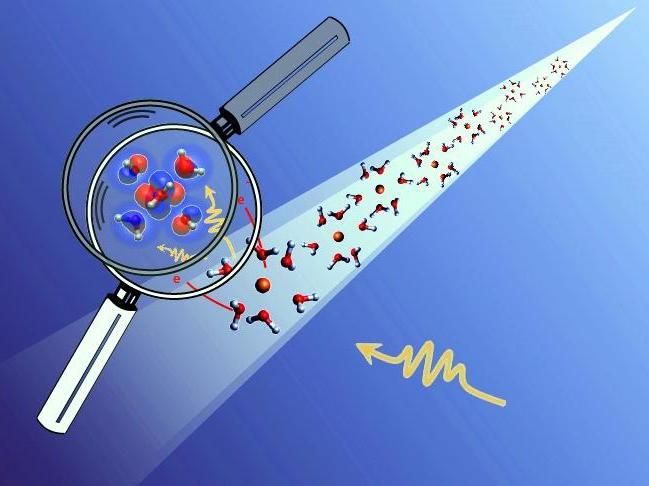Ferrous chemistry in aqueous solution unravelled
Advertisement
The team demonstrated how a detailed picture of the electronic states can be ascertained by systematically comparing all of the interactive electronic processes in a simple system of aqueous iron(II).

Combining the results from radiative and non-radiative relaxation processes enabled a complete picture of the filled and unfilled energy levels to be obtained.
HZB/R. Golnak
If a blindman feels the leg of an elephant, he can conclude something about the animal. And perhaps the conclusion would be that an elephant is constructed like a column. That is not incorrect, but not the whole story either. So it is with measurement techniques: they show a particular aspect very well, yet others not at all. Now an HZB Institute of Methods for Material Development team headed by Professor Emad Aziz has succeeded in combining two different methods in such a way that a practically complete picture of the electronic states and interactions of a molecule in an aqueous solution results.
Simple model system
The hexaaqua(II) cation [Fe(H2O)6]2+ served as the model. It consists of a central iron atom with six water molecules arranged symmetrically about it and is well-understood. A group of theorists headed by Oliver Kühn from the University of Rostock was able to calculate the electronic states and the possible excitations for this system in advance so that the predictions could be comprehensively tested against the empirical data.
Exploring the L-edge with two methods
"The primary soft X-ray emissions generated at BESSY II were perfectly suited for investigating the L-edge, as it is known", explains Ronny Golnak, who carried out the experiments during the course of his doctoral studies. The L-edge denotes the energy region where the important electronic states lie for transition metals like iron: from the electrons in the 1s and 2p shells near the nucleus to the valence electrons in the 3d shells. Electrons from the 2p shells are briefly excited to higher states with the help of X-ray pulses. These excited states can decay via two different pathways: either by emitting light (radiative relaxation) that can be analysed with X-ray fluorescence spectroscopy (XRF), or instead by emitting electrons (non-radiative relaxation) that can be measured with photo-electron spectroscopy as a result of the Auger effect (AES). Applying these methods of analysis to liquid samples or samples in solution has only become feasible the last few years thanks to development of microjet technology.
Combining the results
The interaction between the relaxation channels of excited 3d-valence orbitals in iron and its more strongly bound 3p and 3s orbitals has now been analysed for the hexaaqua complex. Combining the results from the radiative and non-radiative relaxation processes enabled a complete picture of the filled and unfilled energy levels to be obtained.
New insights into catalysts and energy materials
"Our results are important for interpreting X-ray spectra and improve our understanding of electron interactions between complexes in solution and the surrounding solvent for catalytic and functional materials", says HZB-scientist Bernd Winter. Aziz adds: "Experts were skeptical about whether our experimental approach would work. We've now demonstrated it. Naturally, we will carry out this type of measurement on additional systems as well, particularly with catalysts that play a key role in the physical chemistry of energy materials, as well as in biological processes."
Original publication
Ronny Golnak, Sergey I. Bokarev, Robert Seidel, Jie Xiao, Gilbert Grell, Kaan Atak, Isaak Unger, Stephan Thürmer, Saadullah G. Aziz, Oliver Kühn, Bernd Winter & Emad F. Aziz; "Joint Analysis of Radiative and Non-Radiative Electronic Relaxation Upon X-ray Irradiation of Transition Metal Aqueous Solutions"; Scientific Reports; 2016
Other news from the department science
Most read news
More news from our other portals
See the theme worlds for related content
Topic World Spectroscopy
Investigation with spectroscopy gives us unique insights into the composition and structure of materials. From UV-Vis spectroscopy to infrared and Raman spectroscopy to fluorescence and atomic absorption spectroscopy, spectroscopy offers us a wide range of analytical techniques to precisely characterize substances. Immerse yourself in the fascinating world of spectroscopy!

Topic World Spectroscopy
Investigation with spectroscopy gives us unique insights into the composition and structure of materials. From UV-Vis spectroscopy to infrared and Raman spectroscopy to fluorescence and atomic absorption spectroscopy, spectroscopy offers us a wide range of analytical techniques to precisely characterize substances. Immerse yourself in the fascinating world of spectroscopy!




























































